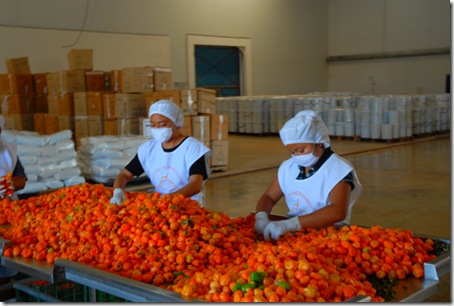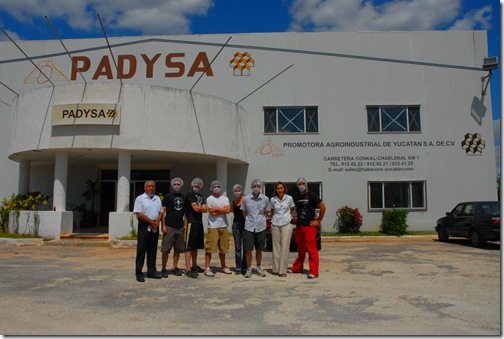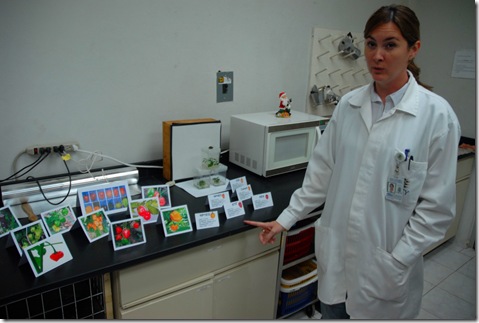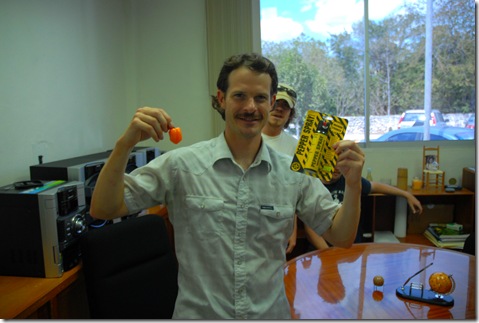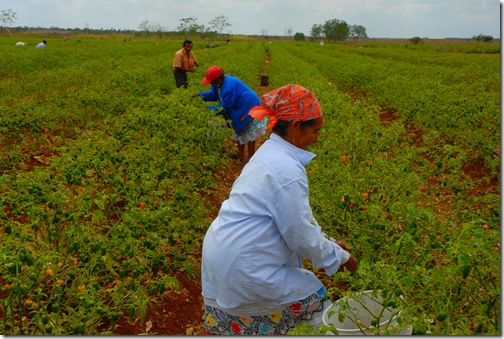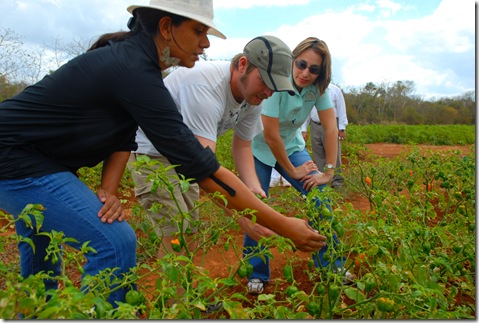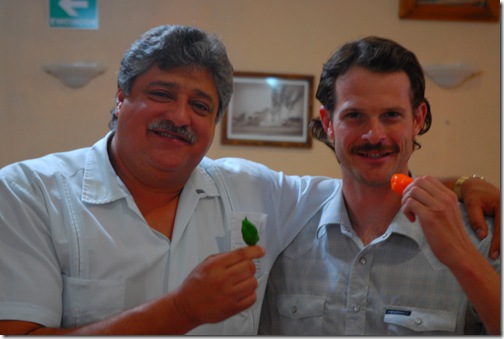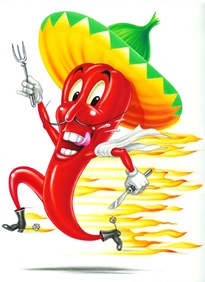 Spicy pepper heat that is. I am a spicy foods person. It does not matter what type of food it is, the spicier the better. Maybe it stems from my development as a child. When my brother and I were younger, if we were ever caught swearing in the house or around my parents, the punishment was a few dabs of Tabasco pepper sauce on the tongue. Little did my mom know that after a while, I started to build up a tolerance to the Tabasco, which she can probably now correlate to an observed increase in my obscene language as I grew up. I can not speak for my brother, but for me, the Tabasco sauce was no longer a suitable deterrent to cursing around the house or in the company of my parents. As I have matured in life, I like to think that the swearing has subsided but the byproduct of my childhood cursing deterrent was the development of an appreciation for hot sauce and it did not take long to venture beyond the familiar taste of Tabasco sauce to bolder and hotter sauces. Ever since I moved out of the house, there has always been at least one bottle of hot sauce in my kitchen. In fact, during some lean budgetary times, a bottle of hot sauce was probably one of the only things you could find in my cupboards. Not because hot sauce was the only thing I had left to eat, it simply was the only thing that made Mac n Cheese and Top Ramen noodles taste better.
Spicy pepper heat that is. I am a spicy foods person. It does not matter what type of food it is, the spicier the better. Maybe it stems from my development as a child. When my brother and I were younger, if we were ever caught swearing in the house or around my parents, the punishment was a few dabs of Tabasco pepper sauce on the tongue. Little did my mom know that after a while, I started to build up a tolerance to the Tabasco, which she can probably now correlate to an observed increase in my obscene language as I grew up. I can not speak for my brother, but for me, the Tabasco sauce was no longer a suitable deterrent to cursing around the house or in the company of my parents. As I have matured in life, I like to think that the swearing has subsided but the byproduct of my childhood cursing deterrent was the development of an appreciation for hot sauce and it did not take long to venture beyond the familiar taste of Tabasco sauce to bolder and hotter sauces. Ever since I moved out of the house, there has always been at least one bottle of hot sauce in my kitchen. In fact, during some lean budgetary times, a bottle of hot sauce was probably one of the only things you could find in my cupboards. Not because hot sauce was the only thing I had left to eat, it simply was the only thing that made Mac n Cheese and Top Ramen noodles taste better.
A few bottles of hot sauce have gone a long way to help me survive the more mediocre gastronomic experiences during the expedition as well. Throughout the trip, I have had the opportunity to try food from all over the globe and believe it or not, most of the people on the planet eat some pretty bland food. Alas, just as soon as I could buy a bottle of hot sauce or have a friend bring one out, it was gone and just when I managed to find another random bottle in a random grocery store in a random country, I could not justify paying the inflated price they were charging for such an unusual and luxurious food product. Do not get me wrong, there are plenty of places in the world where you can indulge in spicy cuisine and move well out of your comfort zone in doing so, but the places in between seem to be much more numerous and the time spent in between much longer. I did manage to light myself up pretty well in Thailand with some spicy tom yum soup, but even when we asked for extra spicy curry in South East Asia or hot chicken in China, most of the time it was pretty bearable. Parts of West Africa spiced up their food a bit but overall, there was actually not really that much in the way of spicy food or even spicy sauce to be found in our travels including much of South and Central America.
Things have changed. We are now on the Yucatan Peninsula. I have been eagerly awaiting and craving for this part of the expedition for some time. The Yucatan is home to the habanero pepper. Touted as one of the hottest peppers in the world, the “Yucatan Killer,” or the “crying tongue” (the name the Mayans used to refer to the little green, orange and red peppers) the habanero has enjoyed unique and perfect growing conditions here on the peninsula for generations. There is even a word here in Mexico for being scorched by a hot pepper… enchilado. The symptoms of enchilado, according to Carl Franz in his People’s Guide to Mexico, include but are not limited to a noisy, desperate sucking of air, head thrown violently backwards, copious sweating, runny nose, and hands clawing at the throat or groping frantically for water. To most people, enchilado and its’ primary cause the habanero pepper are probably things in life to be avoided. However, for me, the habanero is the holy grail of hot sauce and is a tempting, tasty and flavorful additive to any dish. Now that we are in the heart of habanero country, it is an excellent opportunity to see just how hot these little things really are.
Sorting incoming loads of habaneros
TWBR team at the PADYSA production facility
There is no better way to get to the source of something than well, going directly to the source. In Merida, Mexico, the capital of Yucatan State, we were fortunate enough to find Juan Carlos Ledon. Juan is a former professional baseball player turned habanero aficionado and promoter of the regions’ production of the hot peppers. With the help of Juan’s assistant Karla, we toured the Promotora Agroindustrial de Yucatan (PADYSA) habanero production facility. PADYSA is one of the largest exporters of raw habanero products in Mexico and we got to see firsthand how the habaneros are harvested, processed and packaged. The final exported product is pure heat. Just ask Nels… you could see the discomfort in his face and hear it in his throat. All that from just walking around the production facility. The habanero puree and powder exported by PADYSA is ultimately diluted with other various ingredients by companies around the world to make their own hot sauces but they are still some of the hottest habanero products available on the market. According to General Manager Fidel Gonzalez, trying to eat a teaspoon of the pure habanero powder produced by PADYSA would be impossible.
Studying the habanero pepper is a full time job
As an added bonus, we also toured the local government supported research facilities which are devoted to studying various methods of increasing the local yields of the habanero and are even looking for ways to make the peppers even more “pungent.” You would be surprised to learn that as a result of studying the chemical makeup of the habanero peppers, scientists have discovered that their valuable capsaicinoid content can also be used in a variety of non edible applications, everything from use as an anesthetic during surgery, to use as a headache and pain reliever to a potential cure for some forms of cancer. As a result of their chemical composition, the contents of habanero peppers are being added to marine based paints as a natural repellent to barnacles and other marine organisms. The habanero pepper also supports the law enforcement community and aids in personal protection in the form of some very powerful and potent pepper sprays… “the instantaneous effects of the spray cause inflammation of the eye capillaries and all other mucous membranes resulting in immediate blindness, coughing, choking and nausea with extreme discomfort.” Fortunately for criminals and would be attackers, the effects of habanero pepper spray only lasts for 30-40 minutes with no reported permanent damage.
You can eat habaneros and fight crime with them
The following day, we got up early in the morning for a 250 kilometer drive out into the heart of the Yucatan to visit a ranch that has been growing habanero peppers for over three generations. Melitza and her grandfather walked us through the habanero fields giving an enthusiastic explanation of the growing and harvesting process. Fortunately for us, we arrived in Mexico and the Yucatan right in the middle of the habanero harvesting season, so workers were at the ranch hand picking the peppers. It was an interesting and information packed 48 hours as we followed the life of a habanero from seed to plant to pepper to sauce and beyond in the laboratory. These little colorful fruits definitely pack a serious punch and have a lot more beneficial uses than just spicing up your favorite foods. Oh yeah, I almost forgot. You can believe the hype about the habanero being one of the hottest peppers in the world. Not only has scientific testing recently proved that it is among the undisputed heavyweights of flame throwing flora, my taste buds backed up those findings after I downed a full, raw orange habanero pepper. Let’s just say it had to be done in the name of science and exploration.
Habanero harvesting time
Craig flirts with the idea of a new career in picking peppers
Bouey and Juan Carlos playing with fire
INSERT_MAP
